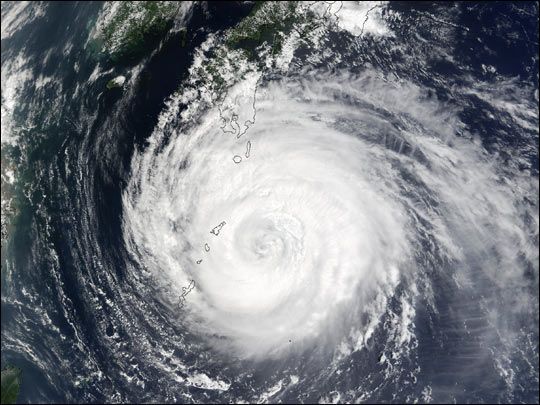Impending Typhoon Khanun Threatens South Korea's Southeast Coast
South Korea braces for Typhoon Khanun, anticipated to hit its southeastern coast later this week with winds reaching speeds of up to 44 meters per second, the national weather agency reported on Monday.
Having swept past an area 330 kilometers east-northeast of Japan's Okinawa earlier today, Khanun is on track to approach waters 90 km southwest of Busan by 9 p.m. Thursday, according to the Korea Meteorological Administration.
As the typhoon inches closer to Busan, it could unleash winds ranging between 33 to 44 meters per second, a force potent enough to potentially disrupt train services. However, the agency emphasized that forecasts could vary as the situation develops.
Post its impact on the southeastern coast, Khanun will likely head north, traversing the Korean Peninsula, introducing winds exceeding 15 m/s throughout South Korea. By Friday morning, projections place the typhoon 40 km northwest of North Korea's Hamhung. By the following day, its strength may wane as it ventures towards China's northeast, transitioning into an extratropical cyclone.
Under Khanun's influence, gales and downpours are expected nationwide until Thursday. Particularly, the southeast coast might endure winds approximating 40 m/s, while other regions can anticipate wind speeds between 15 m/s to 35 m/s. The rainfall forecast estimates showers reaching up to 400 millimeters in Gangwon Province, with other areas receiving between 50 to 200 millimeters.
In preparation for the upcoming typhoon, the government's Central Disaster and Safety Countermeasures Headquarters escalated its disaster alertness level to 2 from its initial status of 1, as of Monday evening.
Interior Minister Lee Sang-min declared the government's proactive measures, emphasizing safeguarding lives by limiting entry to disaster-vulnerable zones, including mountains, underpasses, and dated reservoir areas. As part of the precautions, official plans are in motion to relocate inhabitants of high-risk localities to ensure their safety.
Urgent Evacuation for Scouts Amid Khanun's Threat
As Tropical Storm Khanun edges closer, South Korea is taking swift action. Officials announced on Monday the decision to evacuate 36,000 scouts, predominantly teenagers, from the World Scout Jamboree located in Buan's southwestern county. To facilitate this massive move, over 1,000 vehicles will be deployed starting Tuesday.
Kim Sung-ho, a vice minister at the Ministry of the Interior and Safety, indicated that the scouts, representing 158 countries, will be temporarily relocated to venues within Seoul and its surrounding metropolitan areas. While efforts are underway to secure accommodations at government training and educational facilities, as well as hotels, a comprehensive plan is still awaited.
This preemptive move follows a plea from the World Organization of the Scout Movement, urging the Korean government to safeguard the scouts. An official from Gyeonggi Province, encircling Seoul, revealed ongoing efforts to house approximately 15,000 scouts, hinting at potential arrangements at the Korea International Exhibition Center in Goyang.
Khanun, known for its unpredictable trajectory around Japan's southwestern islands, has already disrupted daily life by causing power outages, heavy rainfall, and interrupted transportation services. As it skirts Japan's Kyushu island, it boasts sustained winds of 108 kph, a strength it's predicted to maintain. Its landfall in South Korea is anticipated on Thursday morning, with winds possibly reaching speeds between 118 to 154 kph.
This evacuation directive aligns with President Yoon Suk Yeol's call for "contingency" plans, emphasizing the relocation of the scouts to the capital's facilities for their safety. Meanwhile, neighboring Japan remains on alert, with advisories about potential mudslides, gusty winds, and turbulent seas.

The Ferocity of Korean Typhoons: A Historical Overview
South Korea's encounter with typhoons isn't a recent phenomenon. Over the decades, these tempestuous storms have regularly marked their presence, often leaving an indelible mark on the nation's landscape and psyche.
Patterns and Seasonality
Typically, the Korean Peninsula faces the wrath of typhoons between May and October, with the peak season spanning from August to early October. This period coincides with the warmer ocean waters of the Pacific, providing the perfect conditions for these tropical cyclones to gain momentum. As the typhoons originate in the western Pacific Ocean, they travel northwest, often making landfall in countries like the Philippines, Taiwan, Japan, and the Korean Peninsula.
A Glimpse into Past Devastations
One of the most notable typhoons in Korea's history was Typhoon Rusa in 2002. With winds surpassing 140 km/h, it resulted in the death of over 200 individuals and caused damages estimated at USD 4.2 billion. It remains one of the deadliest and costliest typhoons in the country's history.
Typhoon Maemi, which struck in 2003, was another devastating force. As one of the strongest typhoons to hit the Korean Peninsula, it caused widespread destruction, with an estimated economic loss of over USD 4.8 billion.
Understanding Typhoon Strength
The intensity of a typhoon is primarily measured by its sustained wind speeds. A Category 1 typhoon, the least intense, has wind speeds ranging from 119 to 153 km/h. Conversely, a Category 5 typhoon, the most intense, boasts wind speeds exceeding 252 km/h. In the context of South Korea, while Category 5 typhoons are relatively rare, the country often finds itself grappling with Category 3 and 4 storms, which are still considerably destructive.
Adapting and Preparing
Over the years, the frequency and intensity of typhoons have raised concerns regarding climate change and its potential impact on the region. South Korea has since taken steps to enhance its disaster preparedness and infrastructure resilience. The nation's focus on early warning systems, reinforced infrastructure, and public awareness campaigns reflects its commitment to safeguarding its citizens against these natural calamities.

